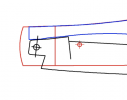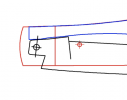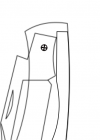Sean, I have thought about the layout problem a bit more and I think the only way to avoid the gap is to use a half-stop angle that is half of the angle when closed. I have tried to illustrate the reason for the gap below in the form of a step-by-step tang layout procedure.
Figure 1: Select a height for your spring, I chose 5mm for this example. To determine the diameter of the circle, pick a size for your tang. Twice the height of the spring seems to be common, so I chose 10mm. To get the diameter of the circle, multiply that by 1.41 (technically, divide by the cosine of half the half-stop angle α). I chose 15mm for the circle shown. Then draw a line from the origin of the circle to a point A on the circumference. A second point B and a third point C are drawn on the circle, each rotated by the half-stop angle α in the clock-wise direction from the previous point.
Figure 2: Align the circle so that point A is at the corner of the spring and point B touches the bottom of the spring. At this point, the first two corners of the tang are determined, points A and B. The third point has to be on the line BC, as that line will coincide with the bottom of the spring when the blade is rotated by the half-stop angle α. To determine the third corner of the tang and the line on which the kick will be, rotate the triangle AOB by the closed angle β in the clock-wise direction to create the triangle DOE. Connect points B and C and points D and E with lines (shown in red). The third point of the tang is on the intersection of lines BC and DE, and the kick is on the extension of line DE. You can now see where the gap you asked about comes from. In the closed position, point D is at the spring corner and the gap is the distance between point D and the corner of the tang found in the previous step.
Figures 3, 4, 5: Connect the points found in the previous steps to draw the tang, and test by rotating the tang around the origin by the half-stop and closed angles. You can see the small gap in Figure 5. To eliminate this gap, you have to make the half-stop angle half of the blade angle in the closed position, i.e., α = β/2. This will make points CD coincident, and the intersection of lines BC and DE will be on the circumference of the circle at C/D, resulting in no gap.
I hope this helps, let me know if anything is unclear.









